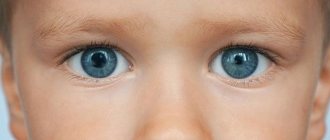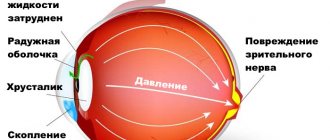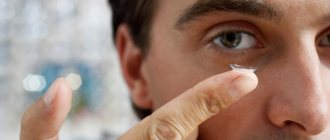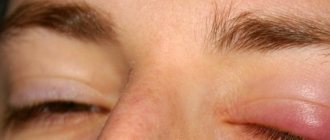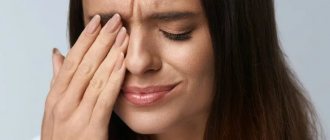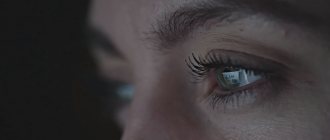Based on the location and nature of pain in the eyes, an ophthalmologist can often suggest the likely cause of the symptom. What diseases may indicate pain that occurs when moving the eyes, we will talk in this article.
A healthy person does not experience painful sensations when he moves his eyeballs - looks down or up, watches moving objects. If your eyes hurt when you move, then there is a problem. This may be severe fatigue of the visual organs, an ophthalmological or general disease. A doctor can determine the exact cause.
Pain and double vision
Pain and double vision can occur with any swelling and inflammation of the tissues inside the orbit, behind the eyeball or the eyeball itself, as well as with disruption of the extraocular muscles. In general, any swelling of the orbital tissue can cause pain in the forehead and eyes. Not all inflammatory processes are visible when examining the eye using optics. When searching for the cause of eye pain, MRI comes to the rescue. Headache in the eye area with double vision and loss of visual fields may be a symptom of inflammation of the optic nerve - retrobulbar neuritis.
MRI scan. Pain in the eyeballs and head, swelling, burning and itching in the eyes, exophthalmos, double vision when moving the eyes, pain in the temples and eyes.
The cause is inflammation in the sinuses. 1 – inflamed, thickened (swollen) eye muscles 2 – source of pain in the eyes – polyps and pus in the sinuses (white on MRI)
Diagnostics
If the eyeball hurts when moving inside, then before treatment it is necessary to carry out diagnostic procedures. They are:
- determining the boundaries of the field of view;
- performing biomicroscopy;
- measuring intraocular pressure;
- performing ultrasound examination of the organs of vision;
- confocal microscopy of the cornea.
To exclude dacryocystitis, a Vesta color test is performed using a contrast agent. Only after diagnosis can the doctor prescribe treatment.
Eye pain during pregnancy
During pregnancy, as the unborn baby grows, the center of gravity of the pregnant woman’s body shifts forward. To return the center of gravity to the center of the support area, the muscles of the back and neck are tensed. Tight neck muscles can compress neck vessels (usually the veins that carry blood from the cranial cavity) and pull on the scalp muscles. Hence the typical pain in the eyes characteristic of pregnant women. You may experience eye pain and headache at the same time. Since medication use during pregnancy is limited, non-drug treatments come to the rescue, primarily osteopathy, similar to the treatment of headaches during pregnancy. More details here
Pain in the forehead and eyes in pregnant women can also be a symptom of increased intraocular pressure. Therefore, the standard of pregnancy management includes periodic examination by an ophthalmologist.
Treatment
Drops to relieve pain and fatigue
- Taufon. Used to relieve inflammation.
- Strix. A special preparation for the correction and restoration of vision.
- Inoxa. A safe remedy for fatigue.
- Blink intensive. Protect and protect your eyes when reading and working at the computer.
Drops to relieve pain and redness
- Vial. Provides anti-edematous and anti-inflammatory effect.
- Visin "Pure Tear". Used to relieve redness and dry eyes.
- Korneregel. Removes signs of inflammation and irritation.
- Irifrin. Good drops for dryness and high intraocular pressure.
Folk remedies
The most popular is, perhaps, a cotton swab soaked in tea leaves (cooled). They need to rub their eyes regularly. The second remedy is calendula infusion (a spoonful of leaves in a glass of boiling water). They need to wipe their eyelids morning and evening. The third folk remedy is chamomile decoction. Steam the inflorescences in a glass of hot water and leave until completely cool.
Pain in the eyes of a child
Most often, eye pain in children occurs due to inflammation and enlargement of the adenoids or tonsils. If a child complains of pain in the eyes, you should listen to his nasal breathing - perhaps it is difficult due to the adenoids. In this case, the child may wheeze and snore in his sleep; in severe cases, he may breathe through his mouth rather than his nose. The more enlarged the adenoids are, the stronger and more often the child’s eyes and head hurt. Enlarged tonsils are visible if you ask the child to open his mouth and breathe through his mouth. Treatment of adenoids and chronic tonsillitis in most cases eliminates eye pain in a child. Pain in the eye area in children can also be caused by severe allergic swelling of the nasal mucosa; in this case, the child most often complains of severe pain in the temples and eyes along with impaired nasal breathing. If the inflammatory process is one-sided, then the eye area hurts on the same side where the nose is stuffy.
General diseases
The organ of vision may be involved in the pathological process in common diseases.
Pain in the eyes occurs in conditions such as:
- hypertonic disease,
- diabetes,
- connective tissue pathology,
- multiple sclerosis,
- blood pathology,
- intracranial hypertension,
- meningitis, encephalitis, brain abscess,
- damage to the ENT organs and oral cavity,
- AIDS.
In this case, pain can be caused by vascular pathology, the occurrence of inflammation of the structures of the organ of vision, the development of thrombosis or sclerosis. If painful sensations appear in the presence of the above-described pathologies, you must inform your doctor about this. Timely treatment of ophthalmological pathology in the early stages will preserve the ability to see and avoid serious complications.
If your eyes itch and hurt. Chronic infection of the nose, throat, stomach and eye pain
Practice has shown that eye pain, burning, itching, redness of the eyes without signs of eye disease can accompany some infections of the mucous membranes of the pharynx, nose and stomach. Apparently, this is due to the fact that the immunity of the mucous membranes is a single system and the immune response to infection can also affect healthy mucous membranes, incl. and eyes. This is especially true for infection with herpes group viruses (herpes simplex, herpes type 6, Epstein-Barr virus, cytomegalovirus), mycoplasma pneumoniae, chlamydia pneumoniae, Helicobacter pylori (the causative agent of gastritis and peptic ulcers). If your eyes hurt or itch, we recommend performing a laboratory examination for these infections and consulting with an immunologist and ophthalmologist. The solution to this problem is to treat infections and restore the immune system.
Severe pain in the temples and eyes is typical for swelling of the nasal mucosa and sinusitis. With unilateral inflammation of the maxillary sinus, the eye area on the side of the sinusitis hurts.
Drug therapy
There are many medications that are used in ophthalmic practice. Some of them can be purchased without a doctor's prescription and stored in a home medicine cabinet in case of need, for example, for conjunctivitis or dry eye syndrome.
The following groups of local drugs are used to treat eye diseases:
- antibacterial (Tsipromed up to 157 rubles, Albucid up to 91 rubles),
- antibiotics (erythromycin ointment up to 26 rubles, tetracycline ointment up to 31 rubles, Tobrex up to 245 rubles, Floxal up to 254 rubles, Normax up to 122 rubles),
- antiseptics that have the property of constricting blood vessels, reducing redness, and providing a slight analgesic effect (Collargol up to 193 rubles, silver nitrate up to 175 rubles, zinc sulfate up to 22 rubles, Furacilin up to 61 rubles),
- antiviral (Oftalmoferon up to 351 rubles, Oftan up to 221 rubles),
- glucocorticoids to relieve inflammation (hydrocortisone ointment up to 29 rubles, Dexamethasone drops up to 49 rubles),
- non-steroidal anti-inflammatory drugs (Diclofenac solution 0.1% up to 49 rubles),
- vitamins for eyes (Retinol 3.44% up to 48 rubles, Taufon up to 140 rubles, Vitafacol up to 221 rubles),
- immunocorrective agents (Poludan up to 155 rubles, Pyrogenal up to 554 rubles),
- membrane stabilizers and antiallergic (Cromohexal 2% up to 112 rubles, Allergodil up to 449 rubles, Opatanol up to 479 rubles),
- “artificial tears” for moisturizing and protecting the cornea in case of “dry eye” syndrome (Oftagel up to 249 rubles, Slezin up to 159 rubles, Videstim up to 101 rubles),
- anesthetics to reduce discomfort (Novocaine up to 30 rubles, Benoxy 232 rubles),
- used for the treatment of glaucoma (Pilocarpine up to 20 rubles, Proxofelin up to 258 rubles, Alphagan up to 671 rubles, Timolol up to 32 rubles, Travatan up to 742 rubles).
Medicines are administered by instillation, instillation and laying, and injection. In addition to the local use of various drugs, ophthalmology uses the prescription of systemic drugs, depending on the clinical situation, by parenteral, intramuscular or intravenous routes.
Dangerous cases
- An inflammatory process accompanied by damage to vision function.
- Tumor of the eye or face, incl. benign or malignant (characterized by eye pain and headache).
- Poor blood circulation in the vessels of the eye or optic nerve (threat of vision loss).
- Serious hormonal disorders, incl. increased thyroid function.
- Attack of angle-closure glaucoma. In this case, the eyes and head hurt badly, or the temple and eye on one side hurt badly, the pain is accompanied by blurred vision, and can be pulsating.
- Acute throbbing pain in the temples and eyes (or pain in one eye and temple) can be a manifestation of migraine.
The eyes can be the target of aggression from the immune system. In this case, the immune system mistakenly recognizes some eye antigens as foreign and destroys them. This is a manifestation of autoimmune diseases such as ankylosing spondylitis, rheumatoid arthritis, systemic lupus erythematosus, Sjogren's disease and syndrome. Post-infectious autoimmune inflammatory processes of the eyes due to certain infections are also possible. For example, this is possible during or after suffering from syphilis, borreliosis, brucellosis, or viral hepatitis. In this case, we will offer you the help of specialized specialists: an immunologist and a rheumatologist. We recommend that you treat pain in the eye area with the utmost seriousness, especially when it comes to a diagnosis that is not entirely clear. It is very important to conduct a full examination and exclude dangerous and urgent conditions and achieve complete clarity in the diagnosis.
Physiotherapy
During the recovery period after an illness, physiotherapeutic techniques are successfully used.
Among the means of physical influence used to treat eye diseases, procedures such as:
- electrophoresis of various drugs,
- ultraphonophoresis,
- magnetotherapy,
- exposure to laser radiation,
- ultrasound,
- UHF.
You should also not forget about eye exercises, which should be done daily. Simple exercises that do not take much time will help prevent eye pathologies and maintain good vision.
The gymnastics complex consists of performing the following exercises:
- Close your eyes for 2 seconds. Blink quickly for 1 minute.
- Alternately shifting the gaze from a near point to a far point.
- Rotate your eyes in different directions.
- Describing various objects and figures with a glance (inverted figure eight, circle, triangle, etc.).
- Light self-massage of the eyelids by pressing on them with your fingertips.
Each exercise is performed 8-10 times. When working for a long time in writing or at the computer, it is advisable to take breaks for gymnastics every 2 hours.
When to see a doctor
For any visual impairment, be it pain, injury, burns or simple discomfort, you must visit an ophthalmologist.
Very rarely, when small particles are ingested, symptoms are completely absent or minimal. The state of discomfort may be minor or may be unbearable. This depends on the nature of the foreign body damage and its location. If you suspect penetration, you still need to see a doctor.
Under no circumstances should you self-medicate; the consequences can be unpredictable.
